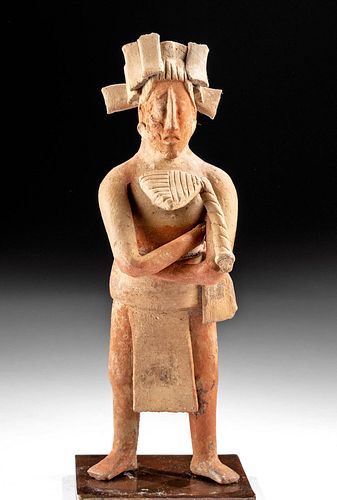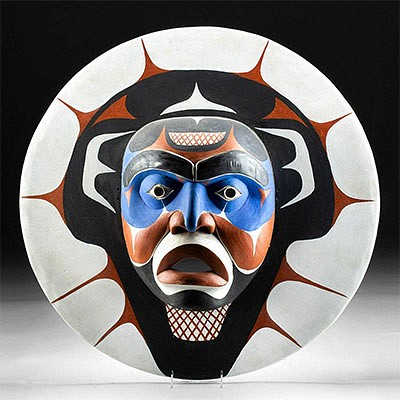Maya Jaina / Campeche Pottery Standing Lord
Lot 7
About Seller
Artemis Fine Arts
686 S Taylor Ave, Ste 106
Louisville, CO 80027
United States
Selling antiquities, ancient and ethnographic art online since 1993, Artemis Gallery specializes in Classical Antiquities (Egyptian, Greek, Roman, Near Eastern), Asian, Pre-Columbian, African / Tribal / Oceanographic art. Our extensive inventory includes pottery, stone, metal, wood, glass and textil...Read more
Categories
Estimate:
$5,000 - $7,500
Absentee vs Live bid
Two ways to bid:
- Leave a max absentee bid and the platform will bid on your behalf up to your maximum bid during the live auction.
- Bid live during the auction and your bids will be submitted real-time to the auctioneer.
Bid Increments
| Price | Bid Increment |
|---|---|
| $0 | $25 |
| $300 | $50 |
| $1,000 | $100 |
| $2,000 | $250 |
| $5,000 | $500 |
| $10,000 | $1,000 |
| $20,000 | $2,500 |
| $50,000 | $5,000 |
| $100,000 | $10,000 |
| $200,000 | $20,000 |
About Auction
By Artemis Fine Arts
Mar 18, 2021
Set Reminder
2021-03-18 10:00:00
2021-03-18 10:00:00
America/New_York
Bidsquare
Bidsquare : Pre-Columbian | Tribal | Oceanic
https://www.bidsquare.com/auctions/artemis-gallery/pre-columbian-tribal-oceanic-6520
Featuring Pre-Columbian, Native American, African / Tribal, Oceanic, much more. All items have been legally acquired and are legal to sell. Convenient in-house shipping. Artemis Fine Arts info@artemisgallery.com
Featuring Pre-Columbian, Native American, African / Tribal, Oceanic, much more. All items have been legally acquired and are legal to sell. Convenient in-house shipping. Artemis Fine Arts info@artemisgallery.com
- Lot Description
Pre-Columbian, Jaina / Campeche Mexico, Maya, Late Classic Period, ca. 600 to 900 CE. So mesmerizing, this fine handbuilt bi-chrome figure depicts a standing Maya lord wearing a loin cloth and sash as well as an elaborate headdress. He also presents a fan delineated in an almost tulip-shaped form with fine incised details over his left arm. The elite figure's visage is one of focused concentration or prayer with closed eyes, a noble prominent nose, slightly parted full lips, scarification marks, and what appears to be a goatee on his chin. Liberal traces of red pigment remain. Size: 6.25" H (15.9 cm); 6.5" H (16.5 cm) on included custom stand.
Jaina figures, from an island off the Yucatan peninsula, are noted for their lifelike faces and their immense detail. Scholars believe that these figures probably represented actual people and were produced in Campeche and brought to Jaina Island to be buried with the deceased. Fascinatingly, the people around Jaina are the only people in southeastern Mesoamerica who put human figures into graves - everywhere else in the region, figures have only been found in domestic contexts. The Spaniard Diego de Landa, who recorded details of Maya life shortly after the Spanish Conquest, wrote that the artists who created pieces like this one lived lives of religious isolation and ritual, both fasting and abstaining.
Provenance: private Hawaii, USA collection; ex-private P.K. Lehnert collection, San Antonio, Texas, USA
All items legal to buy/sell under U.S. Statute covering cultural patrimony Code 2600, CHAPTER 14, and are guaranteed to be as described or your money back.
A Certificate of Authenticity will accompany all winning bids.
We ship worldwide and handle all shipping in-house for your convenience.
#148350Possible loss to end of fan. Nicks to headdress ornaments. Figure may have been repaired with restoration over the breaklines, but if so, this was professionally executed and it is difficult to discern break lines. Expected surface wear commensurate with age, but liberal traces of red pigment remain.Condition
- Shipping Info
-
All shipping is handled in-house for your convenience. Your invoice from Artemis Gallery will include shipping calculation instructions. If in doubt, please inquire BEFORE bidding for estimated shipping costs for individual items.
-
- Buyer's Premium



 EUR
EUR CAD
CAD AUD
AUD GBP
GBP MXN
MXN HKD
HKD CNY
CNY MYR
MYR SEK
SEK SGD
SGD CHF
CHF THB
THB














